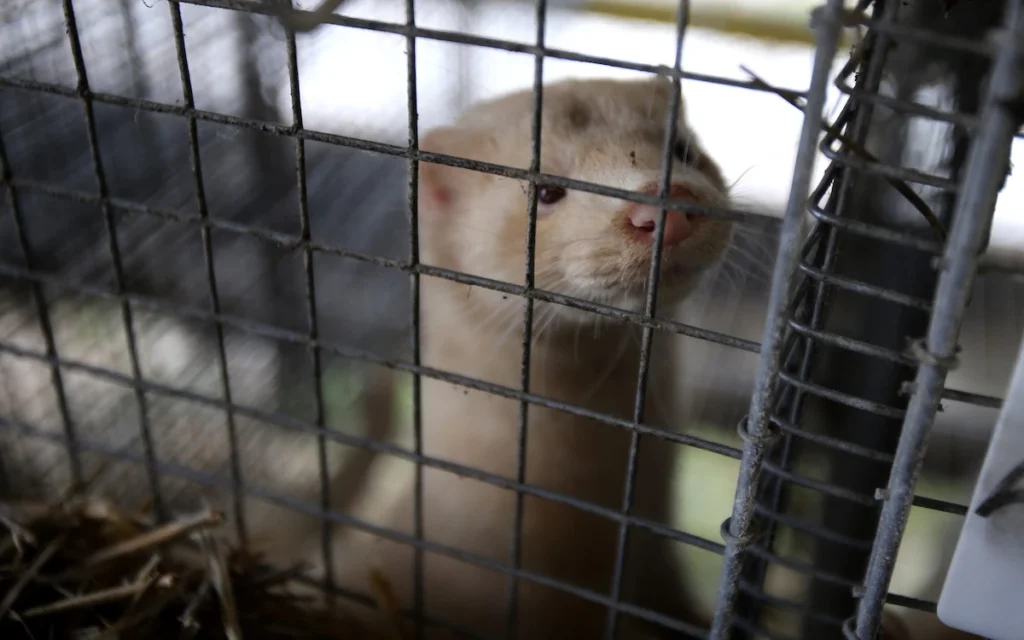
U.S. Senate Urges Nixing of House Provision to Ban Dangerous and Inhumane Mink Farms
See how your U.S. Senators voted on mink farming
- Wayne Pacelle
The U.S. House and the U.S. Senate are seeing mink farming through different lenses, with the Senate looking at the miserable, dangerous fur factory farming sector through rose-tinted glasses.
In early February, the House comfortably passed a ban on mink farming, recognizing that the extreme confinement operations for wild animals are inhumane and also acting as the world’s most menacing spreaders of SARS-CoV-2 variants. Last night though, in a non-binding vote, the Senate ignored the overwhelming body of scientific evidence and recommended to negotiators on a broader bill relating to U.S. competition with China that they nix the House mink farming provision. The motion to instruct conference committee members was led by Senator Ron Johnson, R-Wisc., with a major assist from his Democrat colleague from the state, Tammy Baldwin.
Johnson, who is one of the most vulnerable incumbent Republicans in the November 2022 midterm elections, convinced his fellow Republicans to stick with him on the vote. Baldwin convinced nearly a dozen of her Democratic colleagues, including southern and Sun Belt lawmakers Jon Ossoff, D-Ga. and Mark Kelly and Kirsten Sinema from Arizona, to vote to continue to mass killing of the territorial, semi-aquatic wild animals for fur. Though Wisconsin has seen a steep decline in mink farming, it still is the number one mink-farming state in the country, with 19 farms annually killing about 400,000 mink. In 2020, there were outbreaks at four major mink farms, with more than 10,000 animals succumbing to the disease. (The two Wisconsin lawmakers have also unsuccessfully teamed up to promote federal de-listing of wolves, trying to lift federal protections and expose the wolf families to hound hunting, neck snaring, and even night-hunting.)
The mink-farming debate that has occurred in both the House and the Senate in 2022 is not the first time that the Congress has looked at the mink issue. In 1994, the House and Senate cut taxpayer funding through the Market Promotion Program for foreign fashion shows and advertising to encourage foreign sales of U.S.-produced mink pelts. That amendment passed comfortably in the House, and then overwhelmingly in the Senate. It didn’t kill the mink industry, but there’s no doubt that the industry has been in a downward spiral since that time.
In 1994, according to the U.S. Department of Agriculture, there were 457 mink farms in the U.S., including 78 in Wisconsin. Today, there are 60 throughout the entire U.S., with a third of them in Wisconsin. The biggest factor in the steep decline in numbers of farms and total production over these last three decades has been a vibrant anti-fur movement that has alerted consumers and retailers to the moral and ethical problems in raising and killing these wild, solitary carnivores for their coats.
Nearly every major clothing retailer has stopped selling fur in recent years. Through the years, I’ve personally spoken with Giorgio Armani and Diane Von Furstenberg and executives with Michael Kors, Macy’s, Coach, and other companies to urge them to stop filling their racks with the furs of mink and other beautiful animals. Nearly all the companies in the sector are now on board with the no-fur-sales corporate policy.
With no domestic market for mink, producers have turned to a shrinking number of foreign markets, despite the cut-off of the U.S.-taxpayer promotions in the mid-1990s. Recently, markets in Russia and Ukraine have collapsed, and what’s left is China. There, China’s elite consumers, it turns out, are driving U.S. COVID-19 policies related to commercial wildlife exploitation. Senator Johnson invoked a job argument in making his pitch on the Senate floor last night, even though all U.S. farms generated gross revenues of $47 million and had no profit margins in six of the past seven years.
Bound up with the cruelty and the China connection is the contagion factor. The only documented cases of SARS-CoV-2 spillovers from non-humans and humans have come from mink farms in Denmark, the Netherlands, Poland, Latvia, and Michigan. Unless we shut down mink farms, other variants will almost certainly emerge and threaten human health and the global economy. These variants have collectively infected thousands of people. It’s only dumb luck that the variants have not infected and stricken millions.
We demanded that China clean up its live-wildlife markets after the launch of SARS-CoV-2 from Wuhan. Now, just two years after the pandemic did its invisible work around the globe, we now know that mink on fur farms are uniquely vulnerable to the virus and capable of spilling a mutated pathogen to Americans and other people throughout the world.
All for what? For coats nobody needs in China and for coats nobody wears any longer in America. Promoting this industry, given its viral track record, amounts to tossing any sane risk assessment out the window.
The House deserves plaudits for its work, led by House Appropriations Committee Chairwoman Rosa DeLauro, D-Conn., and Rep. Nancy Mace, R-S.C. The Senate’s action is a colossal moral failure. It may also prove to be a public health catastrophe if mink farms launch the next variant and re-invigorate the pandemic.
(See the Roll Call vote in the Senate here. Yes is the anti-animal vote, NO is the pro-animal vote.)
Note: On May 3rd, Chairwoman DeLauro, Rep. Mace, Representative Peter DeFazio, D-Oregon, and Representative Jared Huffman, D-Calif., wrote a letter with 11 of their colleagues to House and Senate leaders urging them to retain the House mink-farming ban in the final legislation.